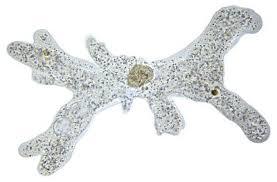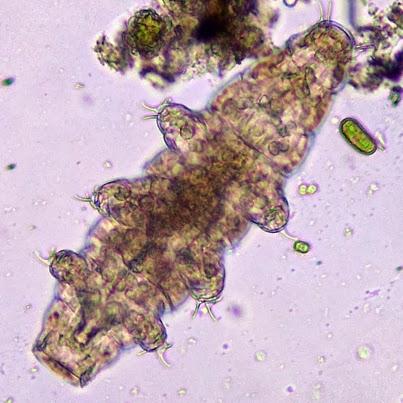Important Microorganisms in Wastewater
Amoeba
Arcella- Shelled amoeba
Proteus- Naked amoeba
Features: Two types of amoeba are found in activated sludge: shelled and naked amoeba. Naked amoeba lack specific shape while the shelled amoeba take the shape of their shell. The shell is made up of sand particles. The yellow color is caused by iron deposits.
Size: The shelled amoeba are 50 to 60 microns in diameter while the naked amoeba are about the same size but change shape.
Habitat: Amoeba like abundant oxygen, large amounts of bacteria and reduced amounts of sludge particles.
Food: Amoeba eat both, particulate food, which is mostly bacteria, and dissolved food, which is absorbed through plasma membrane.
Crawling Ciliates
Features: Also known as creeping ciliates. The body is shaped somewhat like a flea. They are called crawlers because cilia have been modified to form what resemble legs on the bottom-side of its body.
Size: The crawling ciliates are smaller than the free-swimming ciliates (15-30 microns)
Habitat: They like activated sludge with large amounts of bacteria and well-developed sludge particles.
Food: Feeds on bacteria
Free Swimming Ciliates
Features: The body is covered with uniform length cilia and is either foot-shaped or cigar shaped and somewhat flexible. The cell has either one or two large water cavities. It also has a large feeding groove used to trap bacteria.
Size: The free-swimming ciliates are medium to large (100-300 microns).
Habitat: They like activated sludge with large amounts of bacteria and reduced and well-dispersed sludge particles.
Food: Feeds on bacteria
Stalked Ciliates
Features: There are at least a dozen species found in activated sludge. They are oval to round shaped and there is one organism found on each stalk except during cell division. Some species form colonies of organisms. Stalked ciliates consume food via vorticellids, oral cilia that wind completely around the top of the cell. The stalk contains a contractile filament that can rapidly coil up like a spring to cause rapid contraction, which may be a way to avoid predators.
Size: Depending on the species they can be from 30-150 micron in size.
Habitat: They live in the mature sludge particles where they can attach to each other.
Food: Mostly bacteria and other protozoans
Flagellates
Features: Oval shaped body moves in a corkscrew motion by whipping action of one or more flagellum. There are plant types, which are pigmented with chlorophyll and animal-like types, which are nonpigmented. The flagella enables movement as well as the ability to catch food.
Size: 10 to 20 microns
Habitat: Flagellates like abundant oxygen, small bacterial population and a thinner sludge.
Food: Small particles and dissolved nutrients.
Rotifers
Features: They can be sack-shaped, spherical or worm shaped. They have a head, which possesses cilia for movement and food gathering, a body that has a thick cuticle (skin) and foot that has a gland that produces an adhesive for attachment. There are male and female rotifers. The male is much smaller and structurally simpler. Rotifers have reproductive organs and lay eggs. They move by swimming and/or crawling.
Size: 0.2 to 0.8 mm
Habitat: Needs abundant oxygen
Food: They feed upon algae, bacteria, protozoa and dead organisms.
Tardigrade (Water Bear)
Features: Looks like a caterpillar and has claws. They are aggressive feeders, move around a lot and eat continuously.
Size: 0.2 – 0.5 mm in length (size of a dot made with a pencil)
Habitat: Found in aeration tanks with lots of sludge
Food: Body fluids of other microorganisms such as nematodes, rotifers and protozoan.
Nematode (Round Worm)
Features: Most species of nematodes are very similar in appearance. The body is cylindrical, nonsegmented and tapering at both ends. The sexes are separate. Young hatch from eggs. They prefer to crawl over and through the sludge particles. Very few free-living nematodes swim, but when forced to swim they move by whip-like or rapid lashing action.
Size: 0.5 – 3 mm in length and 0.02 – 0.05 mm in diameter.
Habitat: Commonly observed in activated sludge.
Food: They feed upon algae, bacteria, protozoa, rotifers and dead organisms.


